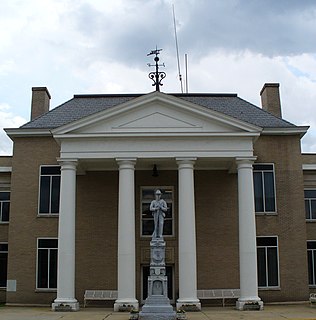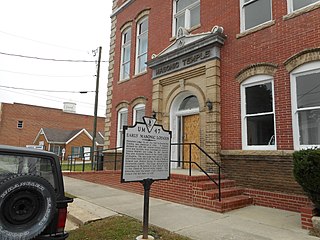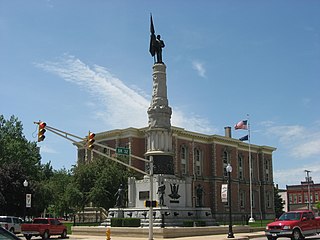
Overton Lodge No. 5 is a Freemason lodge under the Grand Lodge of Tennessee. Overton Lodge is located on the Courthouse Square in Rogersville Historic District in downtown Rogersville, Tennessee in the United States.
Rockford is an unincorporated community and former town in southern Surry County, North Carolina, United States.

Halifax Historic District is a national historic district located at Halifax, Halifax County, North Carolina, US that was listed on the National Register of Historic Places in 1970. It includes several buildings that are individually listed on the National Register. Halifax was the site of the signing of the Halifax Resolves on April 12, 1776, a set of resolutions of the North Carolina Provincial Congress which led to the United States Declaration of Independence gaining the support of North Carolina's delegates to the Second Continental Congress in that year.

The Charlotte Court House Historic District is a national historic district located at Charlotte Court House, Charlotte County, Virginia. The district includes 46 contributing buildings, 2 contributing sites, 3 contributing structures, and 2 contributing objects in Charlotte Court House. The district is centered on the separately listed Charlotte County Courthouse. Other notable buildings include the former county jail (1936), Brick Tavern (1820), Charlotte County Farm Bureau building, St. John's Masonic Lodge (1852), Charlotte County Public Library, Village Presbyterian Church and cemetery (1835), Charlotte Court House United Methodist Church (1841), Diamond Hill, Villeview, W. B. Ramsey House, Charlotte County Elementary School (1908), and Randolph-Henry High School (1939–1940).

Madison County Courthouse Historic District is a national historic district located at Madison, Madison County, Virginia. The district encompasses 66 contributing buildings in the county seat of Madison. In addition to the separately listed Madison County Courthouse, there are a variety of residential, commercial, and institutional buildings dating from the early 19th to the 20th century. Notable buildings include the County Clerk's Office (1832), the Washington Tavern or Eagle House, the Arcade (1830s), Piedmont Episcopal Church (1832-1834), the Madison Presbyterian and Methodist churches (1852-1853), Hunton House Hotel, and the Linn Banks Masonic Lodge (1855).

Tazewell Historic District is a national historic district located at Tazewell, Tazewell County, Virginia. The district encompasses 112 contributing buildings in central business district and surrounding residential area of the town of Tazewell.

Hicksford–Emporia Historic District, also known as Emporia, is a national historic district located at Emporia, Virginia. The district includes 36 contributing buildings and 2 contributing objects in the Hicksford section of Emporia. In 1848, Hicksford was a stop on the Petersburg Railroad. In 1887, the neighboring towns of Hicksford and Belfield merged to form the town of Emporia. The district generally consists of late 19th century or early 20th century, when Hicksford–Emporia began to evolve from a small agricultural outpost to a large commercial and governmental center. Located at the heart of the district is the separately listed Greensville County Courthouse Complex. Other notable buildings include the Citizen's National Bank, the Widow's Son's Masonic Lodge (1905), First Presbyterian Church (1907-1908), Emporia Elementary School, Emporia Armory (mid-1930s), Greensville County Auditorium (1934), and Emporia Post Office (1938). The Old Merchants and Farmers Bank Building is also separately listed.

Windsor Historic District is a national historic district located at Windsor, Bertie County, North Carolina. It encompasses 78 contributing buildings, 1 contributing site, 7 contributing structures, and 1 contributing object in the town of Windsor. It includes residential, commercial, and institutional buildings that primarily date after the turn of the 20th century. Notable buildings include the Bertie County Courthouse and Confederate Monument, Masonic Lodge, Spruill Building, J. B. Gillam House, St. Thomas Episcopal Church, and Cashie Baptist Church (1910).
Downtown Asheville Historic District is a national historic district located at Asheville, Buncombe County, North Carolina. The district encompasses about 279 contributing buildings and one contributing object in the central business district of Asheville. It includes commercial, institutional, and residential buildings in a variety of popular architectural styles including Colonial Revival, Queen Anne, and Art Deco.

Lenoir Downtown Historic District is a national historic district located at Lenoir, Caldwell County, North Carolina. The district includes 41 contributing buildings and 2 contributing objects in the central business district of Lenoir. It includes commercial, governmental, and institutional buildings in a variety of popular architectural styles including Art Deco, Art Moderne, Classical Revival and Tudor Revival. Notable contributing resources include the Center Theater (1941), O. P. Lutz Furniture Company and Lutz Hosiery Mill (1939), Dayvault's Drug Store (1937), Caldwell County Agricultural Building (1937), Courtney Warehouse, Masonic Hall, Miller Building, Confederate Monument (1910), Belk's Department Store (1928), Lenoir Building (1907), J. C. Penney Department Store, Fidelity Building (1928), and U. S. Post Office (1931). Located in the district is the separately listed Caldwell County Courthouse.

Hope Mills Historic District is a national historic district located at Hope Mills, Cumberland County, North Carolina. It encompasses 61 contributing buildings and 3 contributing sites in the central business district of Hope Mills. Ii includes industrial, commercial, religious, and residential buildings and includes notable examples of Federal and Late Victorian style architecture. Notable buildings include the (former) Hope Mills Manufacturing Company buildings, Rockfish Manufacturing Company, Colin MacRae House, Christ Episcopal Church, Lebanon Masonic Lodge No. 391, and Alice L. Gilbert Store.

Downtown Gastonia Historic District is a national historic district located at Gastonia, Gaston County, North Carolina. It encompasses 77 contributing buildings and 1 contributing object in the central business district of Gastonia. The commercial, civic, institutional, and multi-unit residential buildings were built between the 1890s and 1954, and include notable examples of Colonial Revival and Classical Revival architecture. Located in the district are the separately listed former Gaston County Courthouse, First National Bank Building, Third National Bank Building, and Robinson-Gardner Building. Other notable buildings include the U.S. Post Office (1935), York Medical Building (1938), Kress Department Store, Leibowitz Department Store, Ideal Moving Picture Theater, City Hall, Kirby Building (1922), First Baptist Church (1922), Gaston County War Memorial Hall (1928), and the (former) Gaston County Public Library (1930).

Statesville Commercial Historic District is a national historic district located at Statesville, Iredell County, North Carolina. It encompasses 54 contributing buildings in the central business district of Statesville. The district includes notable examples of Late Victorian architecture dated between about 1875 and 1925. Located in the district are the separately listed U.S. Post Office and County Courthouse and Iredell County Courthouse. Other notable buildings include the First A. R. Presbyterian Church, former County Jail, the U. S. Post Office, former Walton and Gage Store, Miller Block, Madison Building, former Merchants and Farmers Bank (1908), former Carolina Motor Company (1916), former Montgomery Ward Store, and former First National Bank.

Downtown Sanford Historic District is a national historic district located at Sanford, Lee County, North Carolina. It encompasses 53 contributing buildings in the central business district of Sanford. The district includes notable examples of Colonial Revival, Tudor Revival and Art Deco style architecture, with buildings largely dated between about 1895 to 1930. Located in the district are the separately listed Railroad House and Temple Theatre. Other notable buildings include the Sanford Buggy Company, McCracken Building, Passenger Depot, City Hall, Coca-Cola Bottling Company, Masonic Lodge, Makepeace Building (1924), Wilrick Hotel (1925), Bowers Building, Cole Pontiac Building, Hubbards Shoe Store (1926), Carolina Hotel (1930), and former U. S. Post Office.

The Wilmington Historic District is a national historic district located at Wilmington, New Hanover County, North Carolina. The district encompasses 875 contributing buildings 38 contributing sites, and 3 contributing structures in the historic core and surrounding residential sections of Wilmington. The district developed after Wilmington was laid out in 1737, and includes notable examples of Queen Anne and Bungalow / American Craftsman style architecture. Located in the district are the separately listed City Hall/Thalian Hall and Alton Lennon Federal Building and Courthouse. Other notable buildings include:

Mount Airy Historic District is a national historic district located at Mount Airy, Surry County, North Carolina. The district encompasses 187 contributing buildings in the central business district and surrounding industrial and residential sections of Mount Airy. They were primarily built between about 1880 and 1930 and include notable examples of Late Victorian and Bungalow / American Craftsman architecture. Located in the district are the separately listed W. F. Carter House and Trinity Episcopal Church. Other notable buildings include the Abram Haywood Merritt House (1902), William A. Estes House, Thomas Fawcett House, J. D. Sargent House (1919), Campbell A. Baird House (1913), T. Benton Ashby House, First Baptist Church (1906-1912), Mount Airy Friends (1904), Presbyterian Church (1907-1914), Merritt Building, Banner Building (1906), Prather Block, Midkiff Hardware Store, Welch Block, West Drug Store, Belk's Building, (former) Workman's Federal Savings and Loan, (former) First National Bank (1893), Bank of Mount Airy (1923), U.S. Post Office (1932-1933), and the Sparger Brothers Tobacco Factory.

Winchester Courthouse Square Historic District is a national historic district located at Winchester, Randolph County, Indiana. The district encompasses 52 contributing buildings and 10 contributing structures in the central business district of Winchester. The district developed between about 1875 and 1950 and includes notable examples of Italianate, Romanesque Revival, and Classical Revival style architecture. Notable buildings include the Randolph County Courthouse (1875), U.S. Post Office (1932), I.O.O.F. Hall, Winchester Community Library (1906), Masonic Lodge, Randolph Hotel, David Building (1927), and W.E. Miller Department Store (1883). Notable structures include the "Spirit of the Doughboy" monument (1928), Lamp of Freedom, Soldiers and Sailors monument (1892), and Laredo Taft Marker.

The Downtown Booneville Historic District in Booneville, Mississippi is a 10 acres (4.0 ha) historic district which was listed on the National Register of Historic Places in 1998. It then included 32 contributing buildings and 16 non-contributing ones.

The Fayette County Courthouse Square Historic District in La Grange, Texas is a historic district roughly bounded by Main, Lafayette, Franklin, Colorado, Jefferson, Washington, and Crockett Streets. It was listed on the National Register of Historic Places on January 16, 2001. Two notable buildings in the district are the Fayette County Courthouse and Jail. Forty–seven buildings, three structures and four objects were identified as contributing to the historic nature of the district.



























